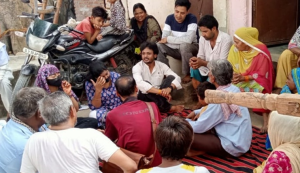Integrated Framing for sustainable livelihoods – A case of Buduni Suanta”, Koraput Odisha
Buduni Saunta, and her husband Natha Saunta now spend greater part the day & night at their ‘Agro ecological farm land ’ located about one kilometre form their village Khajuriput in Gudiaguda Panchayat , Dasmantapur block, Koraput district, Odisha. About 5 acres patch of land at a bald foot hill separated by one pucca road has been very close to their livelihood over the last 12 years- ‘how can we leave it alone, if I have to go out, he stays’, observed Buduni, someone brings food to the farm , cooked at their house in the village, where other family members stay.
A patch of green and well-tended trees standout while undulating empty farm lands and hills of varying shades of grey brown sizzling under the scorching midday Sun.
The transformation of the patch of land which is not different than undulating mass of degraded lands gradually started since the year 2011. When Budununi and Nath, one of the100 Kondh Adivasi families of Khajuriput, decided to use their patch of land differently. Agro forestry, mixed farming, , cover cropping, hedge planting with live fencing.
The sloppy upland of Koraput District which is mainly rainfed has received a huge setback due to effect of weather extremities. Regular cleaning of steep hills till the hilltop without ridges for traditional Podu cultivation has completely exposed the landscapes without vegetation caused soil erosion and reduction of crop diversity. The food produced by tribals is insufficient for the whole year due to erratic rainfall and making them more vulnerable. Though millet was the staple food of the tribal the consumption of rice has been increased since last 2 decades.

Indo-Global Social Service Society through local NGO partner EKTA has piloted Agro ecological farming practices with selected farmers in Koraput District with an objective to reduce the costs of cultivation and climatic risks, stabilise productivity of the small and marginal farmers and generate year-round livelihood opportunities and income. Producing more healthy and nutritious food that is free from chemical residues. Enhancing soil health and regenerating biodiversity.
The couple was already finding it difficult to maintain their family of 6, including 4 daughters, one of them has been married but living with the couple with her husband, out of 1 acres of wet land and about 5 acres of up and slope land.

Buduni is happy with their decision, with the harvest from the mango trees since last few years. She shares a extempore comparison of the land they at present use for the integrated farming of tree crops, seasonal crops and farming of fish as well for the last 10 years. – about 8 quintals of paddy or 6 quintals of ragi/suan or about Rs 6000 worth of alsi (rapeseed) in the year of average rainfall. They used to cultivate the land in a 4 year cycle- upland paddy followed by ragi/ suan the next year and alsi in the third year and keeping the land fallow in the 4th year to rejuvenate.
In 2012, he fenced the patch of land with lantana and brush wood and planted 400 saplings of two varieties of improved mango in 20’ x 20’ spacing from plant to plant and row to row- amrapalli and akhurasa; both would ripe in succession. They are getting around 20000- 40000 from Mango, papaya, and jackfruit each year.


Double benefit: irrigation and recharge of the well and fish from the farm pond
In each Alternate year they are planting banana and papaya on the ridges. They have started intercropping of seasonal vegetables for marketing since August 2013. They grow Maize, Chille, bitter gourd brinjal, cucumber from local good variety of seeds. Their income from these is around 15000 to 18000.
He has now summer crop of maize, bitter gourd, beans, and pumpkin since 2018. Also, they have now small duckery house above the pond. Each year they are releasing around 2000 fingerlings of Rohu and Bhakur (catla) and harvesting after January. In the year 2019 they have fixed the drip irrigation obtained from horticulture department.


Pot irrigation with amrit jal and hormones and inject pits
Buduni is now a model farmer in the region and any new schemes under PKVY, Natural farming the department is eager to demonstrate it with them. They are now not worried about their daughter’s marriage. The Agro forestry cum mixed farming model has revived the degraded landscape. The water table has gone up and the dug well has been recharged. The livelihood has diversified, with 22 different crop varieties; strategic crop selection and rotation, combination of seasonal crops, long duration trees & plants, combination of short, medium and long duration crops of vegetable, spices, tuber crop, creepers, floriculture, horticultural crop, etc. She now takes most of the farming decisions. This is a climate resilience model with less risk and multiple sources of production and providing year-round food security


Low cost Nadev with cow shed and vermin compost unit
Acknowledgement:
We acknowledge the cooperation of the community representatives and the farmers in the intervention areas for their cooperation. The observations are from the field visits and interaction with the farmers.
K C Sahu
Thematic Lead Sustainable Livelihood



